فروری مرکز نظر کے بگاڑ کے بارے میں آگاہی کا مہینہ
Acuity Eye Center and American Academy of Ophthalmology urge the public to get the facts on the most common cause of blindness. Ophthalmologists – physicians who specialize in medical and surgical eye care – have more tools than ever before to diagnose the disease earlier, and to treat it better. But these advances cannot help patients whose disease is undiagnosed or patients who are unaware of the seriousness of their disease. People’s lack of understanding about AMD is a real danger to public health. A recent study showed that most people with AMD don’t realize it’s a chronic health issue that requires regular attention for the rest of their lives.
ایکویٹی آئی سنٹر اور امریکن اکیڈمی آف اوفتھلمولوجی عوام سے اندھا پن کی سب سے عام وجہ کے بارے میں حقائق حاصل کرنے کی امید رکھتے ہیں۔ امراٖض چشم جو آنکھوں کی دیکھ بھال میں ماہر ہیں کے پاس اس مرض کی پہلے سے تشخیص کرنے اور اس کا بہتر علاج کرنے کے لیے کہیں زیادہ طریقے موجود ہیں۔ لیکن یہ پیشرفت ایسے مریضوں کی مدد نہیں کرسکتی ہے جن کے مرض کی تشخیص نہ کی گئی ہو یا وہ مریض اپنی بیماری کی سنگینی سے بے خبر ہوں۔ لوگوں کا اس بیماری کے بارے میں نہ سمجھنا عوامی صحت کے لئے ایک حقیقی خطرہ ہے۔ ایک حالیہ مطالعے سے پتہ چلتا ہے کہ اے ایم ڈی والے زیادہ تر افراد کو یہ احساس نہیں ہوتا ہے کہ یہ انکھوں کی صحت کا لمبا اور پیچیدہ مسئلہ ہے جس پر اپنی باقی زندگی کے لئے باقاعدگی سے توجہ دینے کی ضرورت ہے۔
Age-related Macular Degeneration (AMD) is one of the leading causes of blindness over age 50, affecting about 2.1 million people nationwide. Early diagnosis and treatment are the keys to preventing vision loss. During February, Acuity Eye Center joins the American Academy of Ophthalmology in educating the public about the facts on AMD.
مرکزِ نظر کا بگاڑ ایک ایسی حالت ہے۔جس میں آنکھ کا مرکزِ نظر بگڑ جاتا ہےاور اس کی وجہ سے مرکزی نظر ختم ہو جاتی ہے۔مرکزِنظر کا بگاڑ عموماً ان لوگوں کو متا ثرکرتا ہے۔ جن کی عمر 65سال سے زیادہ ہوتی ہے۔جس کی وجہ سے اس حالت کو بیان کرنے کے لیے”مرکزِنظر کا بگاڑ بوجہ عمر” کی اصطلاح کا استعمال کیا جاتا ہے۔تاہم بعض ادویات مرکزِنظر کا بگاڑ پیدا کر سکتی ہیں۔اور کچھ معاملات تو موروثی بھی ہوتے ہیں۔جیسے سٹارگار ٹ نامی بیماری جو بچوں اور نوجوانوں کو متا ثر کر سکتی ہے۔
AMD is a degenerative disease that happens when part of the retina called the macula is damaged. It’s the part of the eye that delivers sharp, central vision needed to see objects straight ahead. Over time, the loss of central vision can interfere with everyday activities, such as the ability to drive, read, and see faces clearly.
اے ایم ڈی مرکز نظر کی ایک انحطاطی بیماری ہے جو اس وقت ہوتی ہے جب میکولا نامی ریٹنا کا کچھ حصہ خراب ہوجاتا ہے۔ یہ آنکھ کا وہ حصہ ہے جو تیز ، مرکزی نگاہ فراہم کرتا ہے جو اشیاء کو سیدھے دیکھنے کے لئے درکار ہوتا ہے۔ وقت گزرنے کے ساتھ ، مرکزی نقطہ نظر کا نقصان روزمرہ کی سرگرمیوں میں مداخلت کرسکتا ہے ، جیسے گاری چلانے ، پڑھنے اور چہروں کو صاف طور پر دیکھنے کی صلاحیت۔
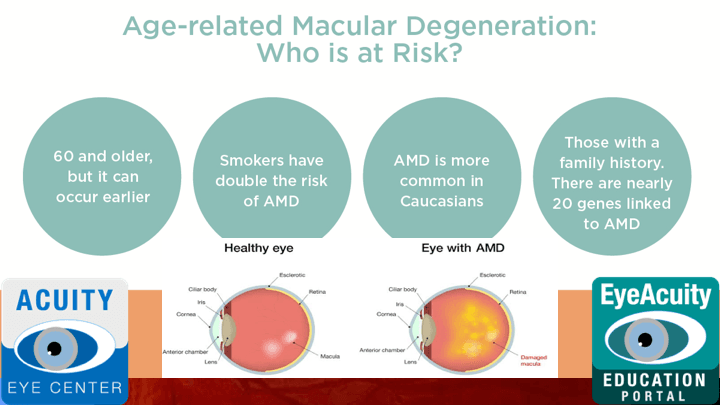
Commonly named risk factors for developing macular degeneration include:
- Aging. Significant vision loss accompanying more advanced forms of AMD increases from fewer than 1 percent among people in their 60s to more than 15 percent among people in their 90s, according to the Canadian Medical Association Journal (February 2004).
- اگر آپ کی عمر 65سال سے زیادہ ہے،آپ سگریٹ پیتے ہیں ، سفید فام ہیں یا آپ کے خاندان میں کسی کو مرکزِنظر کا بگاڑ ہےتو آپ کو اس بیماری کا خطرہ بہت زیادہ ہے۔اگر آپ کلورو قوئن، ڈپریشن یا مایوسی اور نیند کے امراض کی دوائیاں لیتے ہیں۔ تب بھی آپ کو اس بیماری کا خطرہ ہے۔
- Obesity and inactivity. Overweight patients with macular degeneration had more than double the risk of developing advanced forms of macular degeneration compared with people of normal body weight, according to one study reported in Archives of Ophthalmology (June 2003). In the same study, those who performed vigorous activity at least three times weekly reduced their risk of developing advanced AMD, compared with inactive patients.
- High blood pressure (hypertension). Investigative Ophthalmology and Vision Science reported the results of a European study demonstrating that high blood pressure may be associated with the development of macular degeneration (September 2003).
- Smoking. Smoking is a major AMD risk factor and was found in one British study to be directly associated with about 25 percent of AMD cases causing severe vision loss. The British Journal of Ophthalmology in early 2006 also reported study findings showing that people living with a smoker double their risk of developing AMD.
- Drug side effects. Some cases of macular degeneration can be induced from side effects of toxic drugs such as Aralen (chloroquine, an anti-malarial drug) or phenothiazine. Phenothiazine is a class of antipsychotic drugs, including brand names of Thorazine (chlorpromazine, which also is used to treat nausea, vomiting and persistent hiccups), Mellaril (thioridazine), Prolixin (fluphenazine), Trilafon (perphenazine) and Stelazine (trifluoperazine). The American Academy of Ophthalmology notes that findings regarding AMD and risk factors have been contradictory, depending on the study. The only risk factors consistently found in studies to be associated with eye disease are aging and smoking.
7 Ways to Protect Your Eyes from Age-Related Macular Degeneration
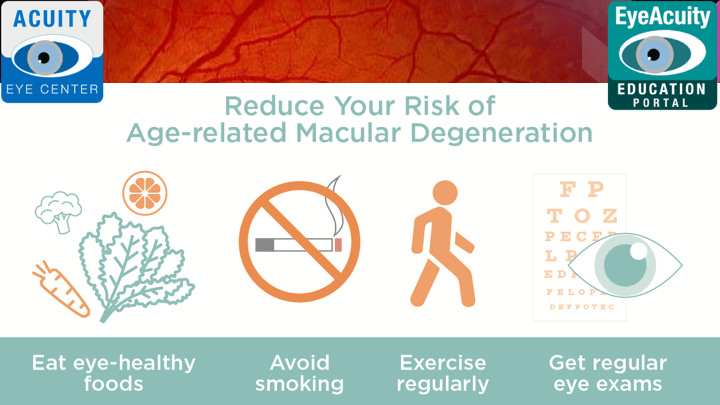
ڈاکٹرزکے مطابق مرکزِنظر کے بگاڑ سے بچنے کی کوئی یقینی صورت نظر نہیں آتی۔ تحقیق ظاہر کرتی ہےکہ بالائے بنفشی روشی اور ممکنہ طور پر نیلی روشی اس مسئلے کی وجوہات ہیں۔اس لیے دھوپ کی عینک جو ان سورج کی شعاعوں کو روکتی ہیں وہ تحفّظ فراہم کرسکتی ہے۔اس کے علاوہ آپ جو کھاتے ہیں وہ بھی آپ کے مرکزِنظر پر اثر کرتا ہے۔محققین کا خیال ہےکہ مختلف حیاتینی مرکبات اور نمکیات پر مشتمل دوائیں مرکزِنظر کے بگاڑ سے بچاؤ میں مدد دے سکتے ہیں۔ورزش کرنے اور سگریٹ ترک کرنے سے بھی آپ مرکزِنظر کے بگاڑ کے خطرے کو کم کر سکتے ہیں ۔
The Academy offers these seven steps to help people take control of their eye health:
1. Get regular comprehensive medical eye exams.
AMD often has no early warning signs, so getting regular comprehensive eye exams from an ophthalmologist is critical to diagnosing and treating eye disease in its early stages. The Academy recommends that adults with no signs or risk factors for eye disease get a baseline eye disease screening at age 40 — the time when early signs of disease and changes in vision may start to occur. By age 65, the Academy recommends getting an exam every one to two years, even in the absence of symptoms or eye problems.
2. Quit smoking.
Numerous studies show smoking increases the risk of developing AMD, and the speed at which it progresses. Smokers are twice as likely to develop macular degeneration compared with a nonsmoker
3. Eat a well-balanced diet.
Many studies demonstrate that eating a diet rich in fruits, vegetables, and nutrient-packed foods, such as salmon and nuts, may reduce the risk of AMD. Research also suggests that patients who ate fresh fish, an important source of omega-3s, were at lower risk of developing AMD.
4. Take the right kind of vitamins.
Vitamins can delay the progression of advanced AMD and help people keep their vision longer if they have intermediate AMD or advanced AMD in one eye. But make sure it’s the right combination of vitamins. A recent study found that some of the top-selling products do not contain identical ingredient dosages to eye vitamin formulas proven effective in clinical trials.
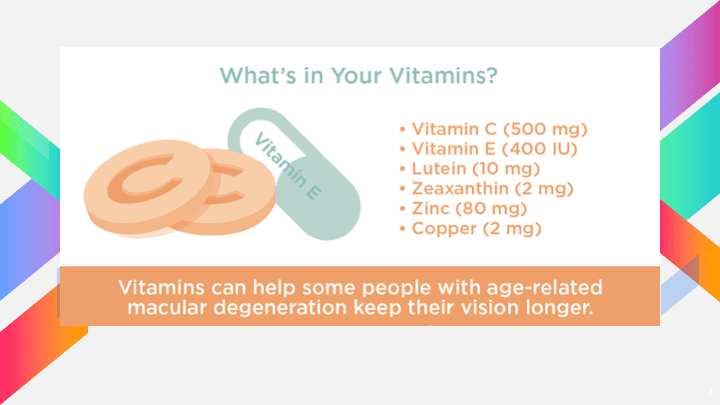
5. Exercise regularly.
Exercising three times a week can reduce the risk of developing wet AMD by 70 percent. Studies also show that physical activity may lower the odds of both the early and late stages of AMD.
6. Monitor your sight with an Amsler Grid.
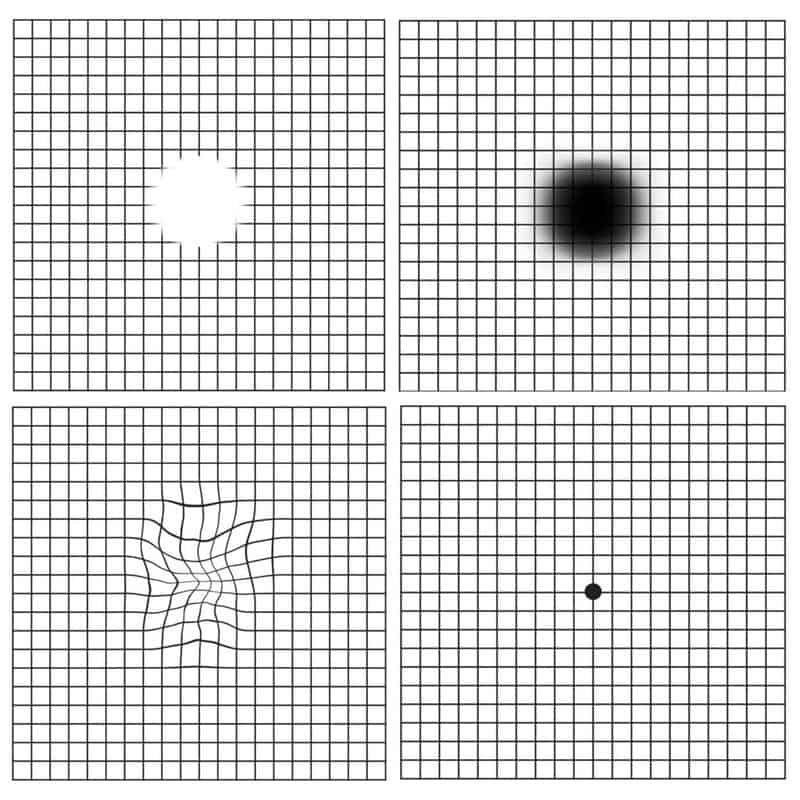
This simple, daily routine takes less than one minute and can help people with AMD save more of their vision. Using this grid is essential to finding any vision changes that are not obvious, so you can report them to your ophthalmologist.
7. Know your family’s eye health history.
If you have a close relative with AMD, you have a 50 percent greater chance of developing the condition. Before your next eye exam, speak with your family about their eye health history. You may need more frequent eye exams based on your family history.
“Most people understand the importance of annual medical examinations,” said Rahul N. Khurana, M.D., a clinical spokesperson for the American Academy of Ophthalmology. “However, we often forget that our eyes also need regular evaluation by a medical doctor. Degenerative diseases, such as AMD, can now be successfully treated, but early detection is imperative to avoid lasting consequences.”
Here is the message from our lead consultant Professor Dr. Zia Ul Mazhry,
” A common Reason for deterioration of vision in old age is age-related macular degeneration (AMD). This condition had been incurable until recently. Many Preventive and curative treatment has become available for AMD. Please get your eyes evaluated for this common reason for legal blindness.”
بڑھاپے میں نقطہ نظر کی خرابی کی ایک عمومی وجہ عمر سے متعلق میکولر انحطاط (اے ایم ڈی) ہے۔ یہ حالت کچھ عرصہ قبل تک ناقابل علاج تھی۔ بہت سے احتیاطی تدابیر اور علاج معالجہ اے ایم ڈی کے لئے دستیاب ہوچکا ہے۔ برائے کرم اندھے پن کی اس عمومی وجہ سےبچنے کے لئے اپنی آنکھوں کا معائنہ لازمی کروائیں۔
How Is Macular Degeneration Treated?
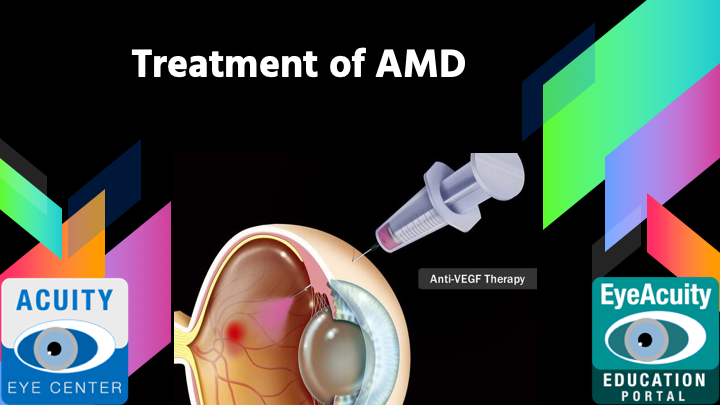
There is as yet no outright cure for age-related macular degeneration, but some treatments may delay its progression or even improve vision.
Treatments for macular degeneration depend on whether the disease is in its early-stage, dry form or in the more advanced, wet form that can lead to serious vision loss. No FDA-approved treatments exist yet for dry macular degeneration, although nutritional intervention may help prevent its progression to the wet form.
For wet AMD, treatments aimed at stopping abnormal blood vessel growth include FDA-approved drugs called Lucentis, Eylea, Macugen, and Visudyne used with Photodynamic Therapy or PDT. Lucentis has been shown to improve vision in a significant number of people with macular degeneration.
لوسینٹس نامی ٹیکے کو جون میں ترقسم کے مرکزِنظر کے بگاڑ کے علاج کے لیےایف۔ڈی۔اے سے منظوری ملی۔ جس نے مزید نظر ضائع ہونے سے بچانے میں مثبت نتائج دیئے۔لوسینٹس سے بینائی بہتر بھی ہوئی ہے۔یہ دوا آنکھ کے اندرونی پچھلے حِصّے میں غیر معمولی خون کی نالیاں بننے سے روکتی ہے۔ایسی طرح ایک دوسری آف لیبل دووائی جسے اےواسٹین کہتے ہیں۔ لوسینٹس کی طرح کام کرتی ہے۔ اےفلی برسیپٹ ایک اور دوا ہےجو تر قسم کے مرکزِ نظر کے بگاڑ کے علاج میں موثر پائی گئ ہے۔وژیوڈائن مرکزِنظر کے تر قسم کے بگاڑ کے علاج کے لیےپہلی دوائی تھی۔ جس کو خاص طور پر ان مریضوں کے لیےاستعمال کیا جاتا تھا ۔جن میں مرکزِنظر کے نیچے روابیتی خون کی نالیاں موجود تھیں ۔وژیوڈائن اور لیزر کو فوٹوڈائی نیمک طریقہ علاج میں استعما ل کیاجاتا ہے۔ان دنوں وژیوڈائن بہت ہی کم استعمال ہوتی ہے۔چند معالج نامیاتی حیاتیں زنک جیسے نمکیات تجویز کرتے ہیں۔جو ایک تحقیق کے مطابق مریض میں مرکزِنظر کے انتہائی بگاڑ کے خطرے کو 28 فیصد تک کم کرتی ہیں۔جن مریضوں کو مرکزِنظرکے بگاڑ کی وجہ سے بینائی کے مسائل ہوں، انھیں ضعفِ بصارت کے آلات سے پڑھنے،کمپیوٹر استعمال کرنے اور دیگر کاموں میں مدد مل سکتی ہے۔
About Eye Health Education By Acuity Eye Center Lahore Pakistan:
Welcome to the Education Portal of Acuity Eye Centre Lahore Pakistan. We are committed to serving our patients and our community, to the development and propagation of new concepts to preserve and enhance vision. Our three missions—clinical service, education, and research—are closely interrelated. Visit: https://eyeacuity.net/education/


